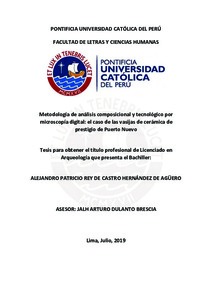| dc.contributor.advisor | Dulanto Brescia, Jalh Arturo | es_ES |
| dc.contributor.author | Rey de Castro Hernández de Agüero, Alejandro Patricio | es_ES |
| dc.date.accessioned | 2019-09-18T16:42:22Z | es_ES |
| dc.date.available | 2019-09-18T16:42:22Z | es_ES |
| dc.date.created | 2019 | es_ES |
| dc.date.issued | 2019-09-18 | es_ES |
| dc.identifier.uri | http://hdl.handle.net/20.500.12404/15020 | |
| dc.description.abstract | Durante el primer milenio antes de cristo las poblaciones centro-andinas experimentaron un
proceso de complejización, tanto sociopolítica como económica, que conllevó a la emergencia
de sociedades más jerárquicas y de líderes que ostentaban gran poder. Este proceso fue
motivado por un fenómeno particular: la expansión e intensificación de redes de intercambio a
larga distancia de bienes de prestigio. Dentro de este contexto, las evidencias recuperadas en el
sitio de Puerto Nuevo, Paracas, presentan una gran oportunidad para caracterizar estas redes
de intercambio y para esclarecer el rol que jugaron las poblaciones de la costa sur dentro de
estas. La gran cantidad de vasijas de cerámica de prestigio recuperadas en Puerto Nuevo,
muchas de las cuales exhiben rasgos estilísticos foráneos, llevó al planteamiento de una
interrogante que guía la presente investigación: ¿estas finas vasijas fueron hechas en la costa
sur (imitación) o fueron traídas desde fuera (importación)? Para contestar esta pregunta se
realizó un análisis composicional por medio de la técnica de la microscopía digital a una muestra
de vasijas previamente seleccionada. El objetivo de este análisis es identificar grupos
composicionales que brinden información acerca de las materias primas utilizadas.
Adicionalmente, se analizaron una serie de variables en aspectos tecnológicos, morfológicos y
decorativos. La correlación de estos resultados permitió reconocer varias comunidades de
alfareros e inferir el carácter local o foráneo de estas (y, por ende, de las vasijas producidas por
estas comunidades). Posteriormente, esta información se usó para determinar los mecanismos
mediante los cuales arribaron estas vasijas a Paracas y, así, poder entender el rol que cumplieron
los habitantes de Puerto Nuevo al interior de las redes de intercambio que imperaron durante
el Periodo Formativo. | es_ES |
| dc.description.abstract | During the first millennium BC, the central Andean populations underwent a complex process
of cultural development, both sociopolitical and economic, that led to the rise of more
hierarchical societies and of leaders that held great power. This process was motivated by a
particular phenomenon: the expansion and intensification of long distance exchange networks
of prestige goods. Within this context, the evidence recovered at the archaeological site of
Puerto Nuevo, Paracas, provides a great opportunity to characterize these exchange networks
and to clarify the role played by the populations of the south coast inside those networks. The
great quantity of finely decorated ceramics found at Puerto Nuevo, many of which exhibit
foreign stylistic traits, led to the formulation of a research question that guides the present
investigation: these fine prestige ceramics were made in the south coast (imitations) or were
brought from other regions (importations)? In order to answer this question, a compositional
analysis was carried out by means of the technique of digital microscopy. The aim of this analysis
is to identify compositional groups that provide information on the source materials employed.
Additionally, a series of technological, morphological and decorative characteristics were
analyzed for each ceramic. The correlation of the results obtained allowed for the identification
of several manufacturing communities and the possibility to infer the local or foreign nature of
those communities (and, by extension, of the ceramics produced by them). This information was
then used to determine the mechanisms by which these ceramic vessels arrived to Paracas,
hence, being able to comprehend the role fulfilled by the inhabitants of Puerto Nuevo within
the exchange networks that dominated the Central Andean Formative Period. | es_ES |
| dc.language.iso | spa | es_ES |
| dc.publisher | Pontificia Universidad Católica del Perú | es_ES |
| dc.rights | info:eu-repo/semantics/openAccess | es_ES |
| dc.rights.uri | http://creativecommons.org/licenses/by-nd/2.5/pe/ | * |
| dc.subject | Paracas, Cultura--Restos arqueológicos | es_ES |
| dc.subject | Cerámica--Perú--Historia--Época prehispánica | es_ES |
| dc.subject | Perú--Restos arqueológicos | es_ES |
| dc.title | Metodología de análisis composicional y tecnológico por microscopía digital: el caso de las vasijas de cerámica de prestigio de Puerto Nuevo | es_ES |
| dc.type | info:eu-repo/semantics/bachelorThesis | es_ES |
| thesis.degree.name | Licenciado en Arqueología | es_ES |
| thesis.degree.level | Título Profesional | es_ES |
| thesis.degree.grantor | Pontificia Universidad Católica del Perú. Facultad de Letras y Ciencias Humanas | es_ES |
| thesis.degree.discipline | Arqueología | es_ES |
| renati.discipline | 222016 | es_ES |
| renati.level | https://purl.org/pe-repo/renati/level#tituloProfesional | es_ES |
| renati.type | http://purl.org/pe-repo/renati/type#tesis | es_ES |
| dc.publisher.country | PE | es_ES |
| dc.subject.ocde | http://purl.org/pe-repo/ocde/ford#6.01.01 | es_ES |






